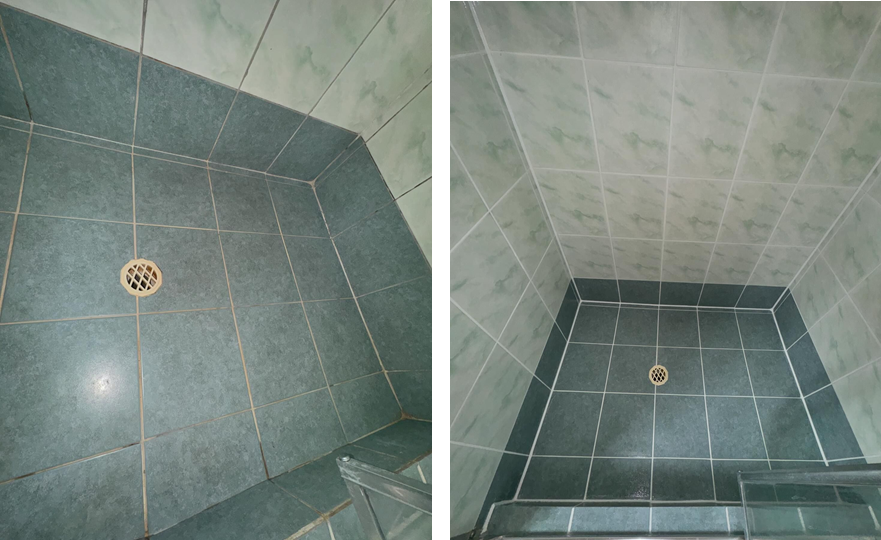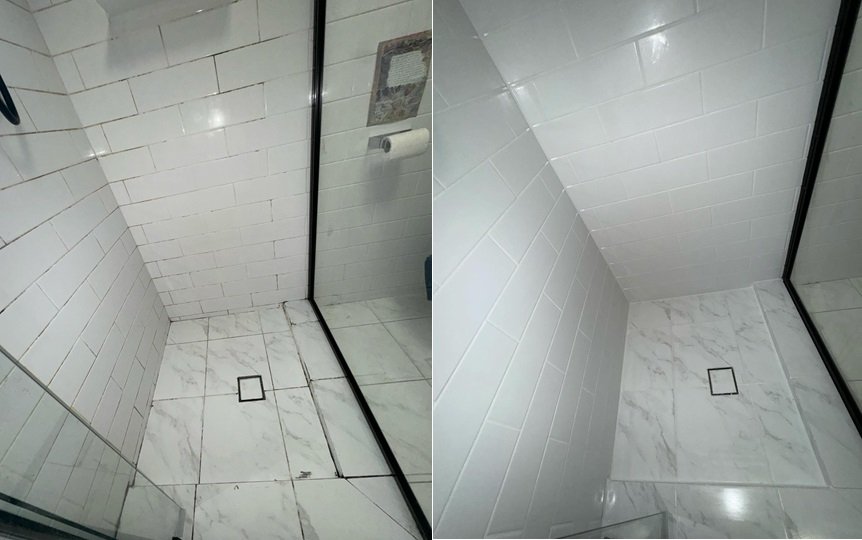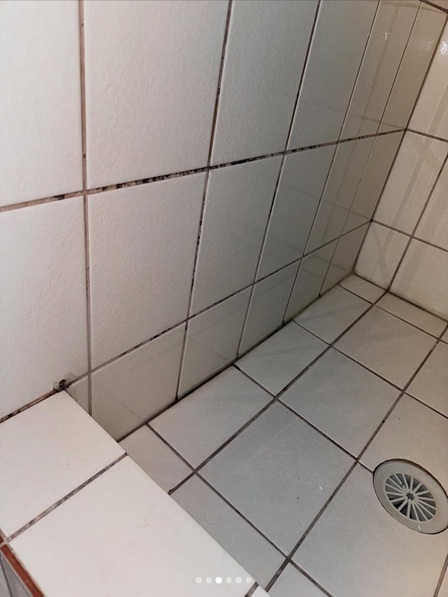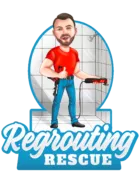Leaking Shower Repairs & Grout Repairs Perth
HIGHEST QUALITY SHOWER & BALCONY REGROUTING AND SEALING SERVICES BY YOUR LOCAL SPECIALISTS IN PERTH, AUSTRALIA
WE DEGROUT ALL IN-DOOR & OUT-DOOR AREAS.
Discover our budget-friendly solutions from Regrouting Rescue, tailored specifically for your leaking showers, balcony, bathroom, and tiles. Our team of skilled professionals will breathe new life into your space, rendering it water-resistant, mold-resistant, and stain-resistant. Say goodbye to the inconvenience of costly re-tiling projects and prepare to showcase your gleaming, rejuvenated areas with confidence! We offer leaking shower repairs in Perth by re-grouting old and cracked grout.
Call us now for an obligation free quote 0411 343 979 or request a quote online.

SHOWER BASE REGROUTING

FULL SHOWER REGROUTING
Full shower regrouting from as little as $550.
EPOXY GROUTE SPECIALIST
WE HAVE A 99% CUSTOMER RATE SATISFACTION!
We take pride in our work and we are proud of our reputation, work ethic and values that we offer to our clients
REGROUTING AREA'S
A leaking shower or water damaged bathroom can cost thousands of dollars if left untreated. We can repair grout in homes and business across Perth without costing you an arm and a leg and without having to remove tiles.
We regrout the following area’s:
Showers
Bathrooms
Balconies
Outdoor Area’s
Our Leaking Shower
REPAIR PROCEDURE
There's a Reason why we spend twice as much time working on your shower than any other company in the market. Quality over Quantity

WHAT OUR TRAINED TECHNICIANS WILL DO DURING THE LEAKY SHOWER OR REGROUTING AREAS REPAIR PROCESS:
Step 1
We initiate the floor and wall degrouting process using our DegroutingRescue tool.
Step 2
After degrouting, we apply our penetrating agent for ongoing protection against dirt and potential water infiltration.
Step 3
Once our Penetrating Agent has settled for protection, we initiate the regrouting procedure by utilizing the strongest and most durable types of grout accessible: Epoxy Grout or Flexible grout.
Step 4
Once our potent grout has settled, we proceed to apply a second coat of our Penetrating Agent to the freshly applied grout. This additional layer enhances protection against chemical agents and aids in easier future cleaning efforts.
Step 5
We initiate the floor and wall degrouting process using our DegroutingRescue tool.
BEFORE & AFTER REGROUTING PHOTOS
REGROUTINGRESCUE.COM.AU - YOU'VE FOUND THE RIGHT REGROUTING RESCUE REPAIRER
When it comes to customer satisfaction, we do not let our folks down in the Perth and Mandurah area. Call us today for your Regrotuing and leaky shower repair needs.
WHY DOES YOUR SHOWER LEAK?
Leaky Shower due to Structural Shifts
Leaky showers, often attributed to building movement, necessitate repairs for various reasons. However, the predominant cause is typically building movement, which occurs in two primary scenarios:
- Settlement of the building into its foundations.
- Natural expansion and contraction of the building in response to temperature fluctuations.
Shower Repairs Needed Due To Weakening Or Cracking
In instances of movement within the bathroom, there may arise a necessity for comprehensive repairs involving the grout, shower seal, tiles, and floor/wall junctions in the shower or bath area. These issues mandate a thorough shower tile repair to prevent water infiltration beneath the tile surface.
Waterproofing Membrane Failure
Typically, there exists a waterproofing membrane beneath the tile surface, intended to prevent water from seeping into adjacent regions. However, these shower sealing membranes are vulnerable to structural shifts, improper installation, and chemical degradation over time. Once compromised, water can infiltrate surrounding spaces, leading to potential damage and necessitating a leaking shower repairs service.
News

How to fix a leaking shower
How to Repair a Leaking Shower Without Removing Tiles A leaking shower is a common household issue, but many homeowners worry that fixing it will require ripping up tiles and carrying out a major renovation. The good news is, in most cases, you can repair a leaking shower without removing any tiles. With the right approach, you can stop leaks, protect your home from water damage, and restore your bathroom’s appearance. Tools and materials you’ll need: Grout removal tool or multi-tool Utility knife or silicone scraper Grout float or applicator Bathroom-grade epoxy grout Mould-resistant silicone

Why You Shouldn’t Ignore a Leaking Shower: Risks & Costs Explained
Why You Shouldn’t Ignore a Leaking Shower: Risks & Costs Explained It’s easy to brush off a leaking shower—maybe it’s just a few drops or a damp patch you notice now and then. But shower leaks rarely fix themselves, and the longer they’re ignored, the more damage they cause. In fact, what seems minor could be a sign of a much bigger issue hidden behind your tiles. If the grout in your shower is flaking or damaged it is time to get your grout repaired before it might become an expensive problem to fix. Here’s

Why DIY Shower Leak Repairs Often Fail
Why DIY Shower Leak Fixes Often Fail (And How to Avoid Expensive Mistakes) Trying to fix a leaking shower yourself might seem like a good way to save money—but more often than not, it ends up costing you more in the long run. Whether it’s cracked tiles or failing grout repairs in Perth homes, what starts as a minor leak can quickly escalate into major water damage, mould growth, and even structural issues if not repaired properly. Here’s why DIY leaking shower repairs often fail—and how you can avoid the most expensive mistakes. Misdiagnosing the

Early Signs of a Leaking Shower
How to Spot the Early Signs of a Leaking Shower in Your Perth Home A leaking shower can silently cause major damage behind your bathroom walls before you even realise there’s a problem. For Perth homeowners, understanding the early warning signs can help prevent extensive water damage, costly repairs, and even mould growth. In this article, we’ll guide you through what to look for and when to call in the professionals for help. If you need professional help fixing a leaking shower in Perth contact Regoruting Rescue on 0411 343 979. Signs Your Shower Might
FAQ'S From Your Leaking Shower & Re-Grouting Specialists
What Is Shower Grout?
Shower grout is a material used to fill the gaps between tiles in a shower. It seals the spaces to prevent water from leaking behind the tiles and provides a finished, polished look. It’s typically waterproof and durable, designed to withstand moisture and frequent cleaning.
Will I Need To Have Tiles Replaced?
Tiles will only need to be replaced if they are cracked.
Can I get a quote over the phone?
Certainly! When it comes to regrouting and sealing showers, the answer is yes! Assuming you have a plumber’s report on hand, our team will conduct a thorough interview to assess the condition of your specific shower. If, for any reason, our technician is unable to address the issue on the spot, they will promptly generate a quotation for you, free of any obligations. (Rest assured, there will be no call-out fees at any point.)
Will there be additional charges once your technician arrives on-site?
While we strive to evaluate as much as possible during our initial phone conversation, there may be instances where unforeseen circumstances arise, necessitating additional work or costs. Rest assured, we will always seek your approval before moving forward with any additional services.
Will your service include cleaning the areas that are being worked on?
Although our main focus is on regrouting showers, indoor areas, outdoor areas, or balconies, rather than cleaning them, our service typically results in a significant improvement in visual appearance as a natural by-product. However, the extent of this improvement depends on the age and condition of the area being worked on. (Please refer to our photo gallery section for before and after photos.) We kindly request that all items be removed from the area and that it be cleaned prior to the commencement of our service, as we are unable to wet the area during sealing.
How long does a standard service take?
A standard service takes anywhere from 2 to 4 hours on a shower to complete. (This depends on the condition of the actual shower or bath.) Other areas such as balconies, driveways, kitchen floors can take anywhere from half a day up to 3 days depending on size.
What constitutes a standard shower?
We will discuss this with you over the phone; however, typically, we consider a standard shower to be a ceramic tiled shower with base dimensions of approximately 1 meter by 1 meter square.
What are the main points that your warranty doesn't cover?
The most important things to let you know up front are:
- Our warranty does not cover plumbing issues.
- We do not cover against the area going mouldy or sealants discolouring over time
- We do not cover against building movement.
What times can I book in my shower to be fixed?
We generally have two standard booking times:
- Between 7:30-8:30 am
- Between 10 – 12 pm
How long after the repairs can I use my shower again?
After we have repaired the grout in your shower or bathroom we recommend you wait 24 hours.
How long after the repairs can I use my shower again?
After we have repaired the grout in your shower or bathroom we recommend you wait 24 hours.
How long after the repairs can I use my shower again?
After we have repaired the grout in your shower or bathroom we recommend you wait 24 hours.
Do I need to remove tiles to fix my leaking shower?
In most cases you do not have to remove tiles to fix a leaking shower. Only if there is a structural issue would you be required to remove tiles.
Areas We Serve


